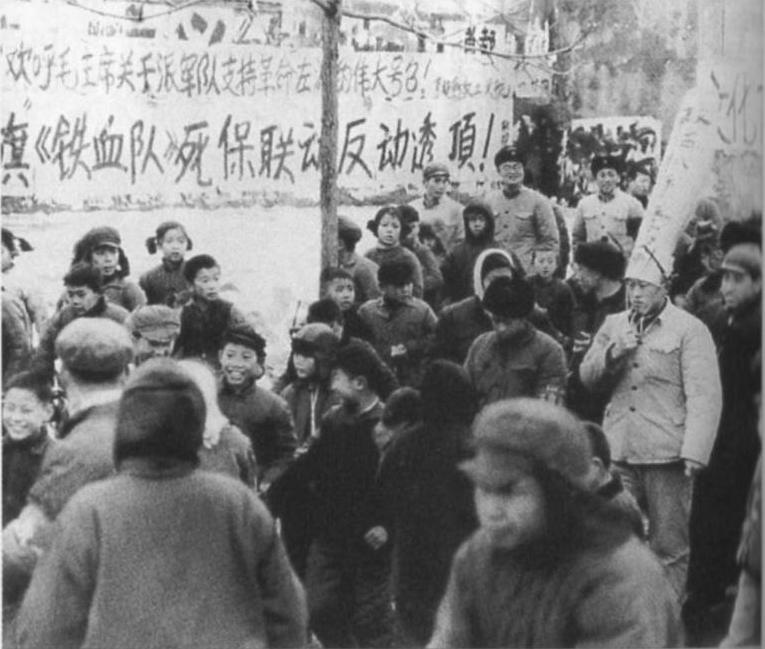
Chinese Cultural Revolution: Traditions--The Four Olds (September 1966)

Figure 1.--Here the Red Guards during the height of the Cultural Revolution are parading a disgraced official through the streets where he can be taunted and villified (1967). Notice how the children are enjoying it. He was acused of bAlso notice the banner which hopefully our Chinese readers can read. He was accused of being a 'political pickpocket' and counter revolutiionary. Note his dummy cap which we unfortunately can not read. He like millions of others were reviled, beaten, hectored in criticism sessions, and forced to admit imaginary crimes. More than a million like him were eventually killed, including President Liu Shaoqi.
|
|
Mao through Lin-Biao launched an assualt on the major institutions of the People's Republic, the Party, the People's Liberation Army (PLA), and the Government. The targets were the intellectual and social remnants of the past. And the older members of these institutions were often but not exclusively targeted. Their assault troops were the Red Guards. The Third Great Mass Rally brought out a million 'rebel revolutionaries' in the Plaza of Heavenly Peace (September 15, 1966). Lin Piao issued new orders to the assembed mass. He decided to focus on the center of 'enemy' resistance. Lin ordered the Red Guards to 'bombard the headquarters' of the opponents within the Communist Party throughout China. Their objective was what Mao saw as the 'four olds', meaning old habits, manners, custom, and culture. This mean essentially the the entire extant civilization of China. The Mao-Lin faction of the Party decided to essentially burn down the Communist house to smoke out their enemies once and for all. Mao had come to belive that the revolution had to be a permanent process, apparently unwilling to accept ant opposition as egitimate. He decided that unending class struggle was needed. The hidden enemies in the Party and intellectual circles needed to be identified and rooted out. Opposition had in reality grown to Mao's peronal leadership because if the disaterous Great Leap Forward. Apparently Mao conceived that the opposition wa holding China back. And critically was threatening his ladership role. Then they would be free to raise Utopia 'on the ashes of the old society'. Major Chinese traditions such as respect for ones's elders and the value of scholarship in particular were attacked. Those targeted were humiliated, detained, beaten, sent to the contryside for hard labor, and not uncommonly murdered. They were persecuted by not only the Red Guards, but neighbours, colleagues and pupils enegized by revolutionary fervor or not infrequently personal grudges. Friends, children and spouses turned on them. Children were often forced to renounce their own parents. Pupil turned on teachers. [Branigan]
Sources
Branigan, Tania. "China's Cultural Revolution: portraits of accuser and accused," The Guardian (February 24, 2012).
CIH

Related Chronolgy Pages in the Boys' Historical Web Site
[The 1880s]
[The 1890s]
[The 1900s]
[The 1910s]
[The 1920s]
[The 1930s]
[The 1940s]
[The 1930s]
[The 1940s]
[The 1950s]
[The 1960s]
[The 1970s]
[The 1980s]
Related Style Pages in the Boys' Historical Web Site
[Long pants suits]
[Knicker suits]
[Short pants suits]
[Socks]
[Eton suits]
[Jacket and trousers]
[Blazer]
[School sandals]
[School smocks]
[Sailor suits]
[Pinafores]
[Long stockings]
Navigate the Children in History Website
[Return to the Main Cultural Revolution page]
[Return to the Main Chinese People's Republic chronology page]
[About Us]
[Introduction]
[Biographies]
[Chronology]
[Climatology]
[Clothing]
[Disease and Health]
[Economics]
[Freedom]
[Geography]
[History]
[Human Nature]
[Law]
[Nationalism]
[Presidents]
[Religion]
[Royalty]
[Science]
[Social Class]
[Bibliographies]
[Contributions]
[FAQs]
[Glossaries]
[Images]
[Links]
[Registration]
[Tools]
[Children in History Home]
Created: 12:25 PM 11/27/2013
Last updated: 12:25 PM 11/27/2013



